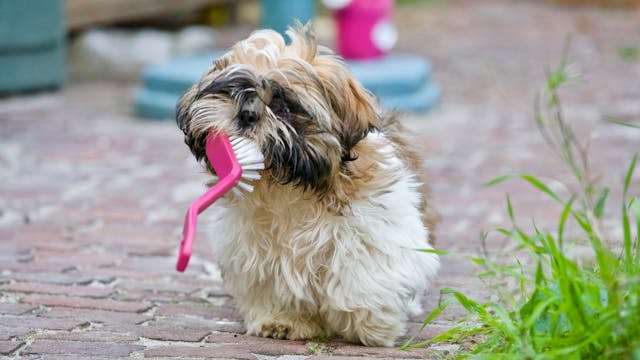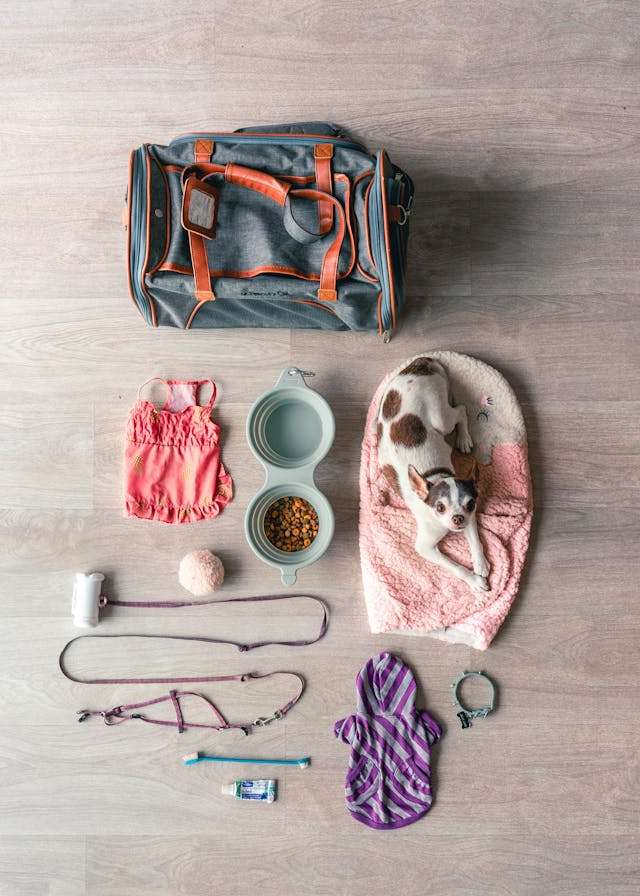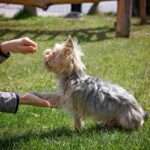Is your dog getting hyped? This indicates that your dog may suffer from anxiety, frustration, stress, or discomfort. When a dog receives discomfort or is in an unfamiliar situation, it may show hyperactive behavior. As a responsible owner, you should address your dog’s hyperactive behavior.
10 Techniques to Calm a Hyperactive Dog
In this article, we will discuss effective ways to calm a dog down. Some techniques will take time, and some will work instantly.
Technique 1: Going for a Walk
Going for a walk can often calm a dog down. If your dog is behaving hyperactively, and you want to calm him down soon, you can try to go for a walk. It’s a method I use with my Golden Mountain Doodle. Here is how going for a walk calms a dog down.
Energy Release
Dogs that don’t burn their energy may show hyperactive behavior in the home. A walk allows your dog to release energy in an appropriate way, leading to calm behaviors.
Bonding Time
While walking with your dog, the bond between you and your dog will strengthen. This bond connection will comfort and secure your dog and make him less anxious. This bond connection often calms a hyperactive dog.
Therefore, you should go for a walk with your dog when your dog is behaving hyperactively. It will also provide a dog with physical exercise.
Technique 2: Stop Giving Attention
If your dog is behaving hyperactively to seek your attention like Long-haired Chihuahuas, then you should not give him attention because it may exacerbate the hyperactive behavior. Your dog may think it’s a way to seek your attention. Here is how to stop giving attention will help to calm your dog.
Attention-Seeking Behavior
Dogs sometimes jump, bark, howl, and paw at you to seek your attention. If you stop giving attention to your dog while showing this hyperactive behavior, it can help them extinguish this behavior. The dog learns through association; therefore, if your dog realizes that showing hyperactive behavior doesn’t get your attention, he will stop doing this.
Consistency
Consistency is the key to achieving anything with dogs. Make sure you and your family members do not give your dog attention while it is showing hyperactive behavior.
Positive Reinforcements
While stopping attention, you should use positive reinforcements such as praise your dog with treats when stopping the Hyperactivity. This will encourage your dog not to show hyperactive behavior.
Technique 3: Stop Loud Noises
Loud noises are harmful to your dog. Your dog may show unusual and hyperactive behavior for loud noises. Dogs often get anxious, fearful, overwhelmed, and confused by loud sounds. Stopping loud noises helps your dog to calm down for several reasons:
Stress Reduction
Loud noises such as thunderstorms, fireworks, construction sounds, or loud music can make your dog stressed and anxious, leading to hyperactive behaviors. Minimizing or stopping these loud sounds can reduce your dog’s stress level and help it calm down.
Relaxation
Dogs want to live in calmer places where they feel safe and secure. If your dog is stressed, you should stop making loud sounds. This will help your dog relax, make him feel secure, and potentially calm him down from hyperactive behaviors.
Technique 4: Avoid Strong Smells
According to Purina, a dog’s sense of Smell is 10,000 to 100,000 times more intense than that of a human. Strong smells can affect a dog’s behavior depending on specific scents and the dog’s experience with the scent. These pungent smells can make a dog hyperactive in various ways:
Stimulation and Excitement
Some strong smells can highly stimulate a dog and increase its excitement, such as the Smell of cooking, the Smell of treats or the presence of other dogs or strangers, leading to behavioral changes like Hyperactivity.
Anxiety and Stress
Some strong smells may increase your dog’s anxiety and stress levels. Generally, unfamiliar and unpleasant smells make dogs feel less secure and can lead to hyperactive behavior.
Therefore, it is better not to use strong smells that are unfamiliar or make your dog hyperactive every time you use them. Avoiding Strong Smells can calm your dog down.
Technique 5: Avoid Forceful Training
Forceful training can make your dog hyperactive over time and can also lead to other behavioral issues. Here is how forceful training makes your dog hyperactive:
Increased Stress
Forceful training techniques, such as physical punishment or Yelling, can increase your dog’s stress level. This can lead to discomfort and make your dog less secure, which is why your dog may show hyperactive behaviors.
Confusion and Frustration
Forceful training is confusing for the dog when it comes to knowing your demands. They may get frustrated and feel uncertain or threatened to find a way of avoiding punishment and earning the reward, leading to hyperactive behaviors.
Reactive Behaviors
Don’t you think your dog can also dominate you while you are punishing him? Your dog may show reactive behavior through hyperactiveness.
Thus, forceful training is never suggested by anyone. Be careful; if you use forceful training methods, your dog may become hyperactive. Therefore, to calm your dog down from hyperactive behavior, you should avoid forceful training methods.
Technique 6: Socialization
Socialization plays a significant role in dogs’ behaviors. Socialized dogs are less prone to behavioral issues like aggression and hyperactivity, and they help reduce anxiety and fear around strangers and other dogs. Here’s how socialization helps to calm a dog down from hyperactive behavior.
Exposure to New Stimuli
Socialization exposes dogs to various stimuli, such as strangers, sounds, pets, sights, and smells. By socializing your dog in the right way, your dog will get used to every stimulus of your society, leading to a calmer temperament and less hyperactive behaviors.
Confident
Socialization makes your dog more confident because it helps your dog get used to other people, dogs, sounds, and smells. Therefore, your dog won’t feel anxious and fearful around anyone. That will make your dog confident and less hyperactive.
Technique 7: Maintaining a Routine
Dogs have their clocks and routines. They love to do everything within a routine. This is one of the environmental factors that shape a dog’s behavior. Let’s know why maintaining a routine is essential to avoid the hyperactive behavior of your dog and potentially a calm dog.
Relaxed and Secure Dog
For a comfortable and secure-feeling dog, you should maintain a routine that is consistent with that. You should make a routine for food, exercise, and training sessions. It will make your dog less anxious, and there will be less chance of making your dog hyperactive.
Therefore, maintaining a routine is essential for your dog to reduce the chances of getting hyperactive.
Technique 8: Physical Exercise and Mental Stimulation
Physical exercise and mental stimulation are required for a healthy and well-behaved dog. You must provide enough physical exercise to your dog regularly to avoid boredom and Mental stimulation to avoid loneliness while leaving your dog alone at home. Enough Physical exercise and Mental Stimulation ensure a less hyperactive dog.
Physical Exercise
Providing physical exercise varies depending on breed, size, age and health issues. However, joint exercises you can provide to avoid hyperactive behaviors are walking, tug-of-war, fetching or hiding, and seeking to stimulate the body and mind.
Mental Stimulation
Mental stimulation through Puzzles, Obedience Training, interactive toys, nose games, and calming activities like a gentle massage, relaxation exercises or quiet time with soothing music.
Therefore, fulfill your dog’s regular physical exercise and mental stimulation to avoid hyperactive behavior.
Technique 9: Groom your Dog
Grooming your dog is an effective way to promote calmness. Fulfilling the grooming requirements of your dog will help reduce behavioral issues such as hyperactivity.
Grooming helps to reduce the stress of dogs. During bathing and brushing, their muscles get relaxed. In addition, bathing will remove all the dirt, berbies and loose of hair from your dog’s coat. Grooming makes your dog clean and comfortable, reducing the chance of getting irritation or anxiety and helping the dog to stay calmer.
Technique 10: Get them Natural Supplements
Various natural supplements are available that can help calm a dog down from hyperactive behavior. However, it’s important to seek suggestions from your veterinarian before adding any supplements to your dog’s diet to ensure its well-being.
Some recommendable natural supplements are Chamomile, Valerian Root, Passionflower, L-Theanine, CBD Oil, and Omega-3 Fatty Acids.







14 thoughts on “10 Techniques to Calm a Dog Down from Hyperactive Behaviour.”